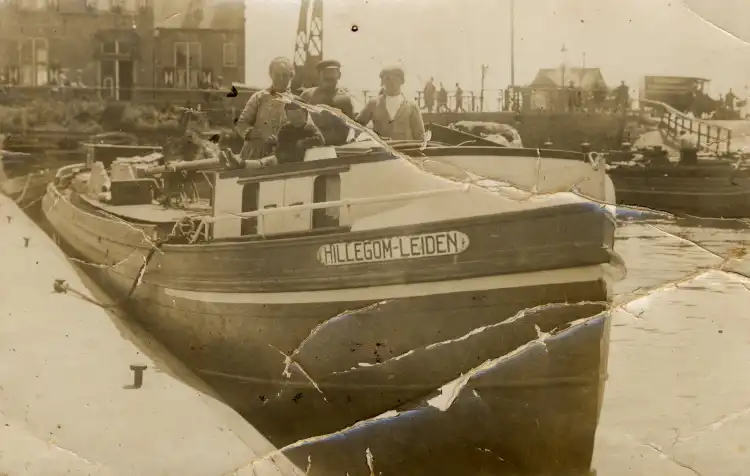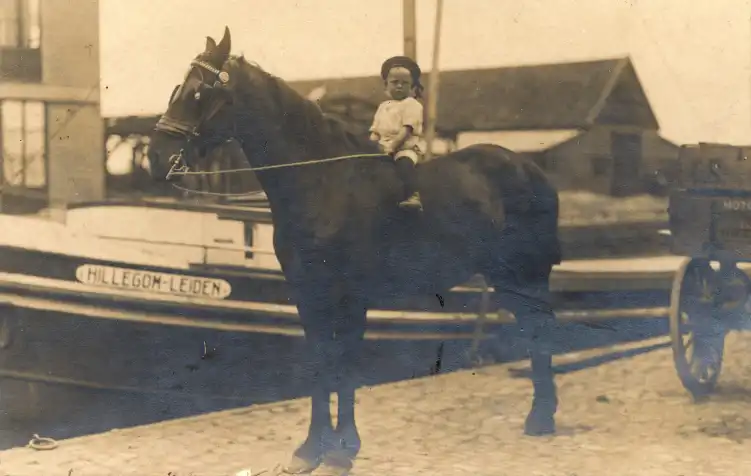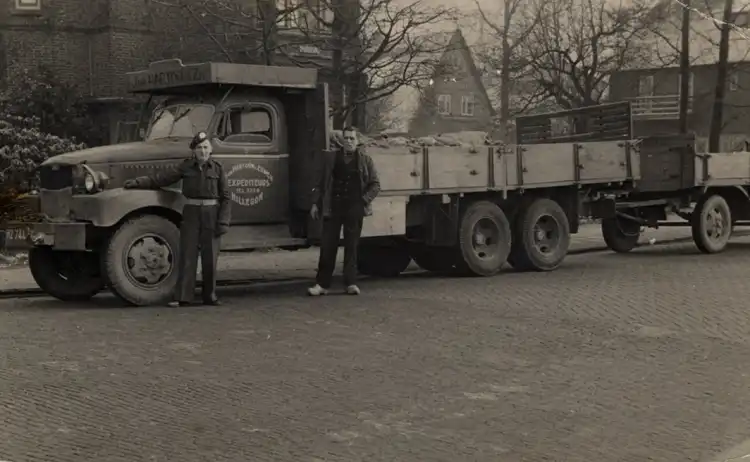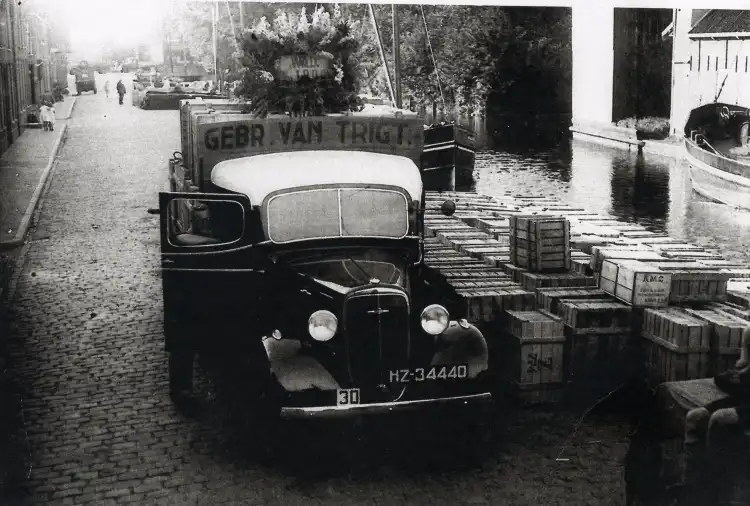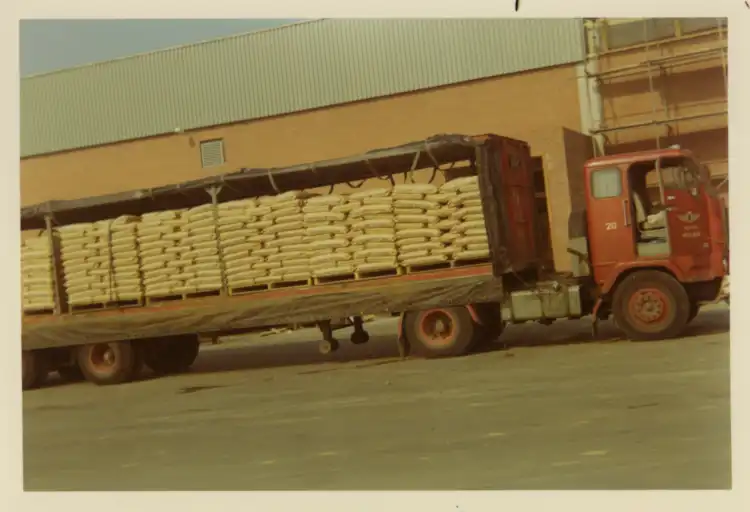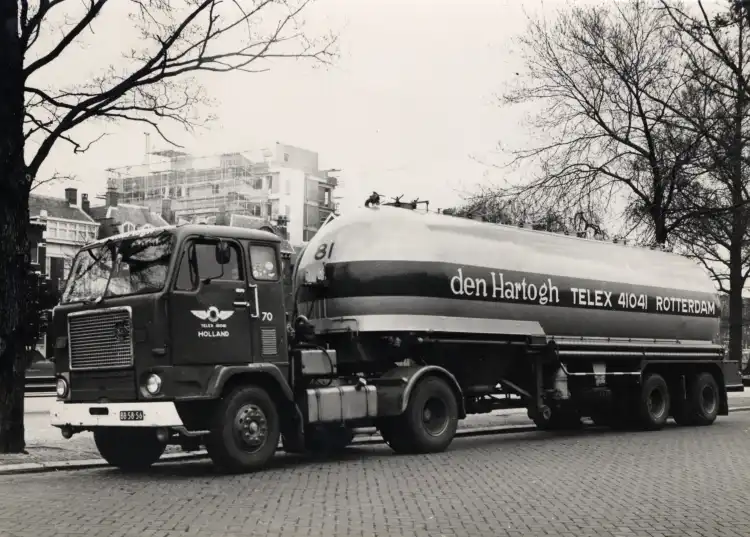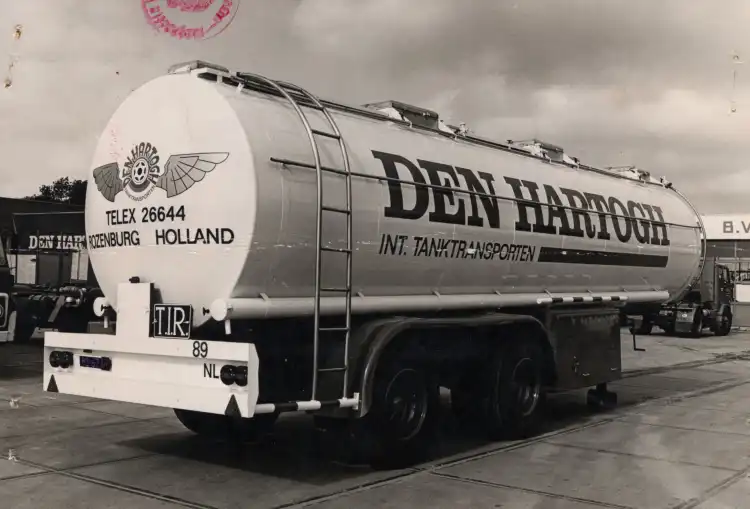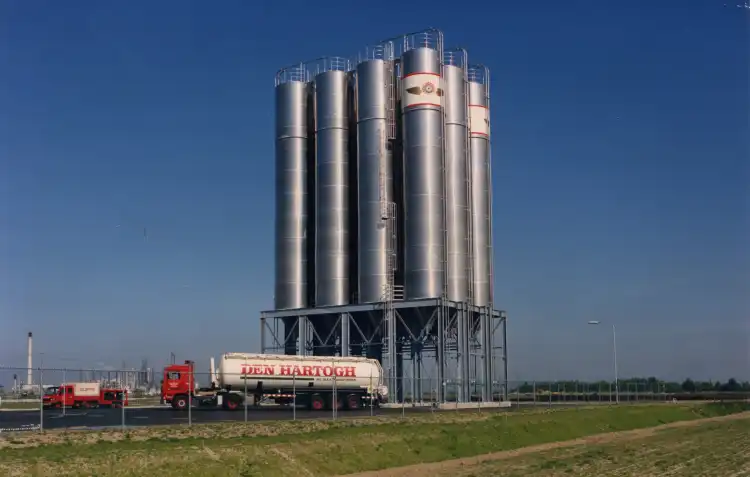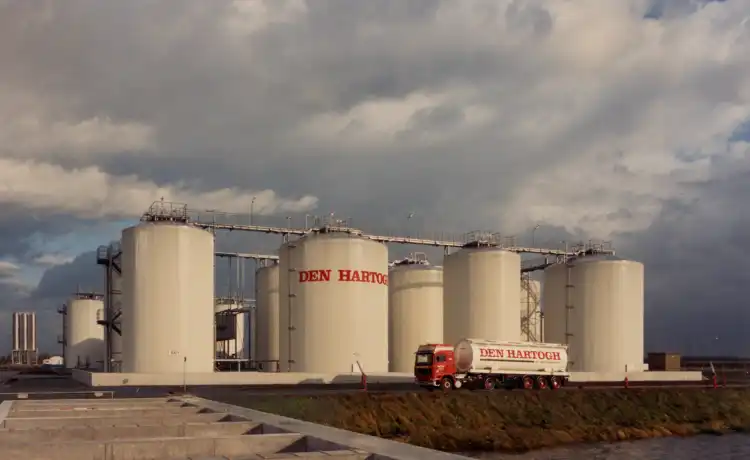The year 2020 marks the start of our anniversary year. A century ago, in 1920, the foundation of what we are today was laid. Enjoy reading about our history. We will update this story biweekly.
How it al began
Jacobus den Hartogh, known as Ko, was born in Ouder-Amstel on 5 March 1894 and married Grietje Cornelia Schuurman, who was the same age, in Abcoude. His occupation shown on their marriage certificate was that of shopkeeper. According to the Hillegom municipal register, the couple moved to Hillegom on 18 February 1919, where Jacobus acquired a grocery store on Beekkade. In October 1922, he sold the shop to concentrate on the transport activities that he’d established in the meantime.
Established in 1920
According to a report dated 24 August 1960 in the NieuweLeidsche Courant newspaper, Jacobus made his first voyage on Friday 27 August 1920 in a rented barge, the Niets zonder Gods Zegen (Nothing without Gods blessing), from Hillegom via De Kaag to Leiden, to deliver miscellaneous cargo goods there for various small businesses in Hillegom. This was the start of his inland shipping activities. Om 28 October 1920, he bought the boat from the owner for 9,750 guilders - a considerable sum of money at the time. Business was clearly going very well. When he registered his company with the Chamber of Commerce Trade Register in 1924, he gave 1920 as the year of the founding of the company. The company operated a regular inland shipping route to and from Haarlem to Hillegom and Leiden and was based at Beekkade 1 in Hillegom. The ship was renamed Hillegom.
The 1920’s
Jacobus transported regular goods like sugar, flour, beets and miscellaneous cargo. Pleasure cruises were also organised from Hillegom to Katwijk aan Zee. It wasn’t long before a 40-ton deck barge was hired as well. The fleet was mainly used for sailing between Leiden and Hillegom, but by the late 1920s, the Zaanstreek area had also joined the range of Den Hartogh’s activities, with Amsterdam (Damrak) being added shortly after that.
The 1930's
A horse and cart soon followed, as did a T-Ford lorry in 1924. The years of economic crisis in the early 1930s were difficult, but Jacobus still managed to slowly expand his modest business. At the time, the company only employed a few people, including skippers De Wit and Van ‘t Woud and Ko’s son, Anthoon, who joined the firm in 1933, at the age of 13. A significant factor in the company’s growth was that of Peka, the manufacturer of canned goods in Hillegom, who became a major customer in 1937. At the end of the 1930s, Den Hartogh had three Ford V8 models in its fleet.
1940-1945
In September 1939, when the United Kingdom and France declared war on Germany and the Dutch army was mobilised, one of Den Hartogh’s lorries was requisitioned by the State. During the occupation, Jacobus buried one of his remaining lorries in a beet pit. By the end of the war, however, it amounted to little more than a pile of rust. The third lorry had been stored at the premises of a friend, a coal merchant. Jacobus had been forced, with a gun to his head, to reveal the hiding place of this lorry to the Germans. Anthoon’s car had also been concealed. When it was discovered by the Germans, Anthoon struck a German soldier. He was immediately arrested but released following payment of several bottles of Dutch gin. Another car was fitted with a wood gas generator and a trailer. This enabled the company to continue its operations, even if it was at reduced capacity.
By 1940, Den Hartogh was firmly established on the market, especially in the Bollenstreek region. This was also the year in which Ko’s second son, Piet, joined the company. However, the Second World War put a temporary stop to the continued development of the business.
At the end of the war the country was in ruins. Transport had ceased. Den Hartogh no longer had any operating vehicles. With a GMC and a Fordson, from the ‘Marshall plan’, Den Hartogh & Zonen started a new period of growth. Two years later, the first, new, post-war truck was purchased – a Chevrolet Loadmaster.
1945-1950
Even before the war, the phenomenon of courier and scheduled services had existed - fixed routes within a region for which a transport operator needed a license. The practice was resumed after the war. But the licensing system hindered expansion; the only way to operate with more vehicles was to take over other transport companies, including their licenses. This marked the start of a period of expansion for Den Hartogh. In 1949, Den Hartogh took over Van Trigt and Van Zelst, with services operating to The Hague and Rotterdam.
Further acquisition of transport companies (Zuidam in 1959, Kempenaar and Kooimans in 1963) enabled Den Hartogh to reinforce its position in the market. Initially mainly in the western Netherlands. Expansion of the parcel delivery service meant that the rest of the country gradually became included in the operating territory.
In 1968 also Rossenaar in Purmerend (two lorries) was taken over. To keep up with the growth of Den Hartogh, a building was constructed on the Van Meerbeekstraat in Hillegom in 1948. Over time (1953 and 1957) this was regularly expanded, and in 1963 Den Hartogh built a distribution warehouse of 2000 M² on the Industriekade in Hillegom.
1960s
Once arrived in the 1960s, Den Hartogh commissioned the construction of a refrigerated truck, thereby daring to enter the adventurous world of international transport. In the late 1960s, Den Hartogh followed in the footsteps of one of its larger customers, ICI (now Huntsman), for which the company had been transporting chemicals since 1949, by relocating to Rozenburg. New offices, a garage and a storage depot were built there. Over the years, the site has developed into a complex of more than 30,000 m².
As well as the courier service (which in 1965 had fifty cars, trucks and trailers), Den Hartogh was expanding in various markets including pallet transport, bulk transport using silo wagons (hoppers) and later bulk tippers.
In the 1960s the running of the transport company was entrusted to Anthoon and Piet den Hartogh, sons of founder Ko. In 1962, Ko became a supervisory director of the company, in which capacity he received the ‘Gold Honorary Medal, linked to the Order of Orange Nassau’, on Queen’s Day 1964. He died in 1966, at the age of 72. In the same year, the third generation entered the ranks of the company, in the shape of 16-year-old Jack, the son of Anthoon. He was followed in 1971 by Jos, Piet’s eldest son.
1970s
We continue our rich history in the 1970s. With further internationalisation in mind Den Hartogh acquired the Belgian companies St. Anna transport in Berlare (1970) including its four licenses, followed in 1976 by Het Hageland in Kaggevinne (twelve licenses) and four years later by CTL in Brussels (fourteen vehicles). The acquisitions were merged in new premises in Zele, Belgium, with a surface area of no less than 30,000 m².
Den Hartogh traditionally carried bulk goods like flower bulbs, sugar beet and, shortly after the war, milk in large tanks, but ultimately specialised in chemicals, thanks to the forward-looking attitude of the family. Chemicals were initially transported in drums, but that was not without risk and the loading and unloading process was labour-intensive. Bulk transport was much more efficient, with the first chemical tankers being purchased in 1970. This marked the start of a spectacular period - Den Hartogh rapidly became specialists in transporting various chemical products, the most important of which were MDI and TDI.
1980s
In the 1980s, the Den Hartogh branch at Rozenburg was again expanded, to 21,000 m². Besides the existing office, garage and storage space a paint shop, automatic washing installation and inspection space for tank trailers were constructed in 1986. Transport of chemicals is subject to strict government regulations in the 1980s - stringent requirements are placed on the material used and on the drivers. In 1989, Den Hartogh obtained the ISO-9002 quality certificate as one of few transport companies to fulfil the SQAS norms CEFIC, which offers customers guarantees regarding quality and safety.
1990s
In Moerdijk, Den Hartogh bought 10 hectares of land in 1990, 5 hectares of which were set up for safe storage of both packaged and bulk goods, and for the processing of a wide range of liquids and granulates. This enabled Den Hartogh to establish itself optimally in the country surrounding the world class ports of Rotterdam and Antwerp. An ultra-modern and multifunctional storage and cross-docking complex for solid and liquid substances was constructed immediately adjacent to the water.
The focus on specialising in the chemicals sector resulted in Den Hartogh being one of the largest specialist transport companies in Europe by the mid-1990s. An extremely important factor in this development was the creation of the European Union. The 1992 Treaty of Maastricht established the EU and laid the basis for closer forms of collaboration in the fields of foreign and domestic security policy, in legal and home affairs and in the formation of the European and Monetary Union. The Schengen Treaties helped create the European internal market, with the free movement of capital, goods, services and people.
Competition increased after 1992 and it was no longer possible to survive only from cargoes on the outward journeys. Following an analysis of the various transport flows, it was decided to arrange for return cargoes to be taken to Germany from Ternate (near Milan), to where MDI was being transported. And it worked. As the destination of these return journeys was Osnabruck, the possibility of opening a branch in Duisburg, a city that was becoming a logistics hotspot in this period, was explored. This became reality in 1995, with the acquisition of the German Brockerhoff transport company, with its four lorries, sixteen trailers, seventeen tanker trailers and two covered trailers. This acquisition marked the start of a further expansion of the European network. More acquisitions followed, including those of Maas, United Bos and Elda in Amiens. However, the network was based primarily on road transport. What was lacking were intermodal destinations,such as the UK, Scandinavia and part of Italy, for which the costs of transport with a driver were too high to operate profitably.
Within the dynamic acquisition process that Den Hartogh initiated in 1992, the absorption of United Bos in Dordrecht (1997) and Eurovos in Oss (2001) boosted international growth tremendously, with access to countries including the UK, Scandinavia and Italy. The entire fleet was enormously expanded in one time. The Tank Cleaning installations of United Bos and Eurovos also came under the management of Den Hartogh.
Den Hartogh’s logistics network was significantly expanded at the end of the 90s by opening more branches in Europe and the acquisition of Elda in Amiens, France (1999) including their tank cleaning facility.
The 2000s
Den Hartogh was responsible for the transport of gases EO (ethylene oxide) and R22 (chlorodifluoromethane) since the 80s. A long-cherished wish to expand gas activities was fulfilled in 2004 with the acquisition of the North French gas transporter STCD and the German Jani Gastransport in 2007. All activities were brought under the management of Den Hartogh’s new strategic business unit Gas Logistics.
We continue our journey through 100 years Den Hartogh in the 2000s when the focus was placed increasingly on global activities. For example, in 2009 Den Hartogh set its sights firmly on the enormous Russian market by acquiring Extar, which specialised in tank container activities. In 2005, a Tank Cleaning installation was opened with a Turkish partner in the Turkish city of Gebze. Four years later, Den Hartogh opened its own branch in Turkey, followed two years later by hubs in Dubai, Houston and Singapore. Gateways to new worlds and new markets.
In 2011, Den Hartogh opened offices in Houston, Dubai and Singapore. The next milestone was the relocation of the head office in 2013, from Rozenburg to Rotterdam, on the banks of the Nieuwe Maas river. The offices in Oss, from where the intermodal activities were managed, also moved to Rotterdam. Twelve years after the acquisition of Eurovos, the creation of one organisation with one business culture and the quest for efficiency and leaner, clearer management of all the activities, was complete.
